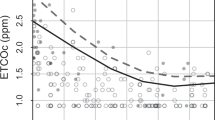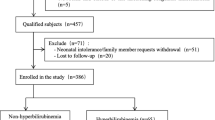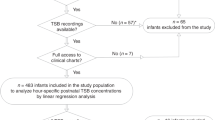Abstract
Objective:
We assessed the relative contributions of increased bilirubin production (indexed by end-tidal carbon monoxide (CO) concentrations, corrected for ambient CO (ETCOc)) to hour-specific total bilirubin (TB) levels in healthy late preterm and term newborns.
Study design:
Post hoc analyses of concurrent ETCOc and TB (at 30±6 h of age) and follow-up TB levels at age 96±12 h and up to 168 h after birth were performed in a cohort of 641 term and late preterm infants.
Results:
Increased bilirubin production (hour-specific ETCOc ⩾1.7 p.p.m. at age 30±6 h) was noted in ~80%, 42% and 32% of infants in the high-, intermediate- and low-risk TB zones, respectively. One infant with TB <40th percentile and ETCOc <1.7 p.p.m. developed TB ⩾95th percentile at age 168 h, probably due to decreased bilirubin elimination.
Conclusions:
Infants in the high-risk quartile of the hour-specific bilirubin nomogram have a higher mean bilirubin production. Infants with TB levels ⩾95th percentile without increased bilirubin production have impaired bilirubin elimination.
This is a preview of subscription content, access via your institution
Access options
Subscribe to this journal
Receive 12 print issues and online access
$259.00 per year
only $21.58 per issue
Buy this article
- Purchase on Springer Link
- Instant access to full article PDF
Prices may be subject to local taxes which are calculated during checkout


Similar content being viewed by others
References
American Academy of Pediatrics. Management of hyperbilirubinemia in the newborn infant 35 or more weeks of gestation. Pediatrics 2004; 114: 297–316.
Bhutani VK, Johnson L, Sivieri EM . Predictive ability of a predischarge hour-specific serum bilirubin for subsequent significant hyperbilirubinemia in healthy term and near-term newborns. Pediatrics 1999; 103: 6–14.
Kaplan M, Muraca M, Hammerman C, Rubaltelli FF, Vilei MT, Vreman HJ et al. Imbalance between production and conjugation of bilirubin: A fundamental concept in the mechanism of neonatal jaundice. Pediatrics 2002; 110: e47–e51.
Maisels MJ, Pathak A, Nelson NM, Nathan DG, Smith CA . Endogenous production of carbon monoxide in normal and erythroblastotic newborn infants. J Clin Invest 1971; 50: 1–8.
Stevenson DK, Vreman HJ . Carbon monoxide and bilirubin production in neonates. Pediatrics 1997; 100: 252–254.
Stevenson DK, Bartoletti AL, Ostrander CR, Johnson JD . Pulmonary excretion of carbon monoxide in the human infant as an index of bilirubin production. II. Infants of diabetic mothers. J Pediatr 1979; 94: 956–958.
Stevenson DK, Bartoletti AL, Ostrander CR, Johnson JD . Pulmonary excretion of carbon monoxide in the human newborn infant as an index of bilirubin production: III. Measurement of pulmonary excretion of carbon monoxide after the first postnatal week in premature infants. Pediatrics 1979; 64: 598–600.
Stevenson DK, Ostrander CR, Hopper AO, Cohen RS, Johnson JD . Pulmonary excretion of carbon monoxide as an index of bilirubin production. IIa. Evidence for possible delayed clearance of bilirubin in infants of diabetic mothers. J Pediatr 1981; 98: 822–824.
Stevenson DK, Vreman HJ, Wong RJ, Contag CH . Carbon monoxide and bilirubin production in neonates. Semin Perinatol 2001; 25: 85–93.
Balaraman V, Pelke S, DiMauro S, Cheung S, Stevenson DK, Easa D . End-tidal carbon monoxide in newborn infants: observations during the 1st week of life. Biol Neonate 1995; 67: 182–185.
Stevenson DK, Fanaroff AA, Maisels MJ, Young BW, Wong RJ, Vreman HJ et al. Prediction of hyperbilirubinemia in near-term and term infants. Pediatrics 2001; 108: 31–39.
Bhutani VK, Stark AR, Lazzeroni LC, Poland R, Gourley GR, Kazmierczak S et al. Predischarge screening for severe neonatal hyperbilirubinemia identifies infants who need phototherapy. J Pediatr 2013; 162: 477–482 e471.
Vreman HJ, Wong RJ, Harmatz P, Fanaroff AA, Berman B, Stevenson DK . Validation of the natus CO-Stat end tidal breath analyzer in children and adults. J Clin Monit Comput 1999; 15: 421–427.
Beutler E, Gelbart T, Demina A . Racial variability in the UDP-glucuronosyltransferase 1 (UGT1A1) promoter: a balanced polymorphism for regulation of bilirubin metabolism? Proc Natl Acad Sci USA 1998; 95: 8170–8174.
Bosma PJ, Chowdhury JR, Bakker C, Gantla S, de Boer A, Oostra BA et al. The genetic basis of the reduced expression of bilirubin UDP-glucuronosyltransferase 1 in Gilbert's syndrome. N Engl J Med 1995; 333: 1171–1175.
Kaplan M, Renbaum P, Levy-Lahad E, Hammerman C, Lahad A, Beutler E . Gilbert syndrome and glucose-6-phosphate dehydrogenase deficiency: a dose-dependent genetic interaction crucial to neonatal hyperbilirubinemia. Proc Natl Acad Sci USA 1997; 94: 12128–12132.
Shibahara S, Kitamuro T, Takahashi K . Heme degradation and human disease: diversity is the soul of life. Antioxid Redox Signal 2002; 4: 593–602.
Maisels MJ, Kring E . The contribution of hemolysis to early jaundice in normal newborns. Pediatrics 2006; 118: 276–279.
Dennery PA, Seidman DS, Stevenson DK . Neonatal hyperbilirubinemia. N Engl J Med 2001; 344: 581–590.
Newman TB, Xiong B, Gonzales VM, Escobar GJ . Prediction and prevention of extreme neonatal hyperbilirubinemia in a mature health maintenance organization. Arch Pediatr Adolesc Med 2000; 154: 1140–1147.
Keren R, Bhutani VK, Luan X, Nihtianova S, Cnaan A, Schwartz JS . Identifying newborns at risk of significant hyperbilirubinaemia: a comparison of two recommended approaches. Arch Dis Child 2005; 90: 415–421.
Tidmarsh GF, Wong RJ, Stevenson DK . End-tidal carbon monoxide and hemolysis. J Perinatol 2014; 34: 577–581.
Bhutani VK, Johnson LH, Jeffrey Maisels M, Newman TB, Phibbs C, Stark AR et al. Kernicterus: epidemiological strategies for its prevention through systems-based approaches. J Perinatol 2004; 24: 650–662.
Johnson LH, Bhutani VK, Brown AK . System-based approach to management of neonatal jaundice and prevention of kernicterus. J Pediatr 2002; 140: 396–403.
Author information
Authors and Affiliations
Consortia
Corresponding author
Ethics declarations
Competing interests
The authors declare no conflict of interest.
Additional information
Jaundice Multinational Study Group
David K Stevenson, Ronald J Wong, Hendrik J Vreman and James R MacMahon (Department of Pediatrics, Stanford University School of Medicine, Stanford, CA, USA); Avroy A Fanaroff (Department of Neonatology, Rainbow Babies’ and Children’s Hospital, Cleveland, OH, USA); M Jeffrey Maisels (Department of Pediatrics, Wm. Beaumont Hospital, Royal Oak, MI, USA); Betty WY Young (Department of Pediatrics, Pamela Youde Nethersole Eastern Hospital, Hong Kong, China); Chap Y Yeung (Department of Pediatrics, Queen Mary Hospital/Tsan Yuk Maternity Hospital, Hong Kong, China); Daniel S Seidman and Rena Gale (Department of Pediatrics, Bikur Cholim Hospital, Jerusalem, Israel); William Oh (Department of Pediatrics, Women’s and Infants Hospital, Providence, RI, USA); Vinod K Bhutani and Lois H Johnson (Section on Newborn Pediatrics, Pennsylvania Hospital, Philadelphia, PA, USA); Michael Kaplan and Cathy Hammerman (Department of Neonatology, Shaare Zedek Medical Center, Jerusalem, Israel); Hajime Nakamura (Department of Pediatrics, Kobe University Graduate School of Medicine, Kobe, Japan).
Rights and permissions
About this article
Cite this article
Bhutani, V., Wong, R., Vreman, H. et al. Bilirubin production and hour-specific bilirubin levels. J Perinatol 35, 735–738 (2015). https://doi.org/10.1038/jp.2015.32
Received:
Revised:
Accepted:
Published:
Issue Date:
DOI: https://doi.org/10.1038/jp.2015.32
This article is cited by
-
A “Gold Standard” Test for Diagnosing and Quantifying Hemolysis in Neonates and Infants
Journal of Perinatology (2023)
-
Reference intervals for end-tidal carbon monoxide of preterm neonates
Journal of Perinatology (2022)
-
ABO hemolytic disease of the fetus and newborn: thirteen years of data after implementing a universal bilirubin screening and management program
Journal of Perinatology (2018)
-
Clinical trial of tin mesoporphyrin to prevent neonatal hyperbilirubinemia
Journal of Perinatology (2016)



